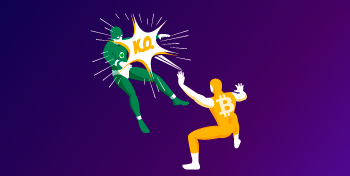Until September 2020, Polkadot was virtually unknown to ordinary investors. By November 2020, its market capitalization was $ 5 billion. This has become the largest conversation in the field of blockchain technology.
What is Polkadot and what is its value?
There are several good reasons for the massive interest in this block chain. The main one of these reasons is that it has great prospects in promoting decentralized applications, including decentralized finance (DeFi).
Polkadot is an open source multichain that facilitates interaction between other blockchains. It allows you to transfer tokens, data, and any type of asset through the blockchain. This compatibility distinguishes Polkadot from other blockchains, such as Ethereum.
Polkadot was launched by Parity as an open source project in 2017, with the goal of building an “open society working in peer-to-peer networks”. The project is supported by the Web3 Foundation, which promotes a decentralized network. The founders are Dr. Gavin Wood, Robert Habermeier, and Peter Chaban. Wood is also a co-founder of Ethereum.
The Polkadot structure consists of four components:
- A relay chain is a core that promotes consensus and interaction between different chains. This also creates overall security in the multi-chain.
- Parachains are independent chains that can create their own tokens.
- Parathread is also an independent chain that can create its own tokens, but in a more flexible model.
- Bridges are systems that facilitate the interaction of parachains, parathreams, and external chains, such as Ethereum.
The Polkadot multichain is also called an ecosystem. This ecosystem currently has more than ten independent network partners, including Edgeware, Centrifuge, Acala, Polymath, Chainlink, Katal, ChainX, Laminar, Dock, Ocean Protocol, and Energy Web Foundation.
- Why is Polkadot unique?
Polkadot can process transactions in multiple chains simultaneously. This parallel processing capability provides Polkadot scalability that other chains lack. Polkadot allows you to create your own chains that can quickly connect to the network. Applications developed by these custom chains can interact with each other.
The creators of decentralized applications really dreamed of interaction. This is due to the fact that in order to achieve true independence and flexibility of the blockchain, different chains must interact. After all, the future of blockchain is custom – built chains that interact with each other, not one blockchain that would manage them all. The Polkadot Ecosystem project will facilitate interaction between independent networks.
Polkadot is not the only platform focused on interacting with blockchains. There is also Cosmos, but Polkadot has attracted more attention because Polkadot’s Substrate Framework offers more flexibility and makes it easier to run a new blockchain.
- Creating and Protecting independent blockchains

The Polkadot ecosystem promotes the creation and protection of independent blockchains. These blockchains can be public or private. They can also take any form; private networks of consortia, networks without permissions, and other Web 3.0 technologies.
The Polkadot ecosystem is tied to a basic structure called Substrate. This allows you to quickly develop parachains that initially work in the ecosystem. This is a significant advantage in the rapid development of blockchain applications. Polkadot Relay Chain APIs provide seamless connectivity for fast and cost-effective development of decentralized applications.
One of the main features of the project is overall security, which ensures that anyone can quickly deploy a new block chain without having to worry about the complex task of protecting the chain. Thanks to the data availability and reliability scheme, chains can connect and interact independently of each other, but still benefit from a single security protocol.
Polkadot can be upgraded without forks. Branching the blockchain creates a separate blockchain. Anyone who does not get into the new fork continues to deal with blocks that are incompatible with the new block chain. Avoiding forking is a significant advantage for the stability of the network and its value. This will prevent the uncertainties that have been observed in other chains, such as different versions of Bitcoin and Ethereum.
One of the most notable projects built on Substrate is Chainlink (LINK). The Chainlink parachain will transfer the Chainlink decentralized oracles to the Polkadot network. This will allow Polkadot app developers to connect their smart contracts and develop apps without creating oracles from scratch.
- How does Polkadot differ from Ethereum?
Polkadot is being compared to Ethereum 2.0, which is an update to the Ethereum blockchain. Both use sharding to address scalability, latency, and transaction throughput issues.
Blockchains, such as Ethereum 1.0, are built on the Proof of Work (PoW) mechanism. This is a consensus protocol that certifies that each transaction will be recorded in the distributed registry as true. In the PoW blockchain, each node (computer) records all transactions in the chain.
The transaction must be authenticated by most of the participating PoW nodes, which makes PoW chains very slow. Ethereum 1.0 processes a transaction in about 6 minutes, while VisaNet processes 1,700 transactions per second.
Sharding solves the slowness problem of PoW. Simply put, this is breaking the chain into smaller pieces (shards). Each node is responsible for recording and authenticating transactions in its local shard, instead of authenticating all transactions as in PoW.
Nodes in a segmented network can still see what data is on other nodes for authentication purposes, but processing and storage is decentralized.
- Beacon Chain vs. Relay Chain
Although Ethereum 2.0 and Polkadot are segmented networks, there is a slight difference in how they work. Ethereum 2.0 uses the Beacon Chain, which connects various parallel shards to exchange information. Only shards with the correct structure can connect to the Beacon Chain.
Polkadot uses a Relay Chain to connect various shards (parachains). Each parachain works independently. However, Polkadot’s Relay Chain is more flexible than the Beacon Chain in terms of receiving shards. Each shard (parachain) sets its own rules (meta-protocol). The Relay Chain accepts various parachains that are executed by the Relay Chain validators using the standard WebAssembly, which provides higher interoperability than the Beacon Chain. External chains are connected to the Polkadot ecosystem using bridged chains.
In fact, applications from Ethereum 2.0 can connect to the Polkadot ecosystem, but Polkadot applications cannot connect to Ethereum 2.0. This is because the Beacon Chain Ethereum 2.0 does not offer a bridge for decentralized applications (dApps) developed outside of the Ethereum ecosystem, as does Polkadot’s Relay Chain.
A good example of an Ethereum-based bridged parachain is Moonbeam, which allows Ethereum 2.0 applications to run in the Polkadot ecosystem. There is also news that the Bitcoin parachain will be wrapped. This will allow users to issue 1: 1 Bitcoin-backed assets on Polkadot, like PolkaBTC, which can be used to enable decentralized exchanges, stable coins, and lending protocols.
- Scalability

Polkadot’s comprehensive approach to (dApps) is the reason it is more attractive than Ethereum 2.0. It accepts applications created outside of the Polkadot ecosystem by way of a bridge. The fact that applications created in other chains and in common programming languages can connect to it makes it very scalable.
Polkadot’s higher interoperability offers a significant advantage over Ethereum 2.0. This allows developers to use other networks, but still connect to the Polkadot ecosystem and use a larger network. The limited compatibility of Ethereum 2.0 has not yet solved this scalability problem.
This is a kind of native tools approach (BYOT) involving a bridge. Polkadot’s bridges allow it to communicate with economically independent and technologically diverse chains. Developers do not need to learn Substrate (the Polkadot framework) to create applications that run on Polkadot. They can deploy their existing resources, which reduces the cost and speeds up the development cycle.
Scalability is key for DeFi developers. The scalable segmented network allows them to create financial applications that are not inferior in performance to the current networks of the owners, but will work very cheaply and be more secure.
- The Race in the Blockchain Market
Polkadot development is complete, while Ethereum 2.0 is still being developed, although full functionality has been promised by 2021. Although the Ethereum brand has been around for a long time, Polkadot is an easily accessible, fully functional segmented network.
DApp developers don’t have to wait for Ethereum 2.0 to become fully functional. It’s hard to imagine how developers using Polkadot’s enhanced compatibility will be persuaded to turn to Ethereum 2.0.
What potential does Polkadot have? The cryptocurrency based on the Polkadot network is a token called DOT. Smart contracts in the Polkadot ecosystem are activated by DOT exchange. There are 922,842,928 DOT tokens trading at around $ 35.81 each. They are already popular both for trading in the cryptocurrency markets and for generating passive income in stacking.
One of the reasons for Polkadot’s rapid growth in market capitalization is that investors believe Polkadot is grossly undervalued. This is because its innovative interoperability and scalability capabilities can be deployed in many real-world applications.
But perhaps the greatest potential lies in the applicability of Polkadot to create functional decentralized applications in various spheres of life. The most obvious is decentralized finance (DeFi). The scalability and faster processing speed of Polkadot, for example, can allow exchanges to process transactions faster and reduce bureaucratic processes while operating in a fully decentralized manner.
Polkadot applications will help you take advantage of blockchain technology in the field of security and transparency for financial applications. The full potential of blockchain technologies in finance was not possible, because areas such as stock markets or ATM networks require very high transaction speed and scalability. Once the upgrade is complete, Ethereum 2.0 can only process 100,000 transactions per second, while companies that do work with data, such as Alibaba, easily reach 583,000 transactions on peak days. According to Gavin Wood, Polkadot has both speed and scalability, and can theoretically provide 1 million transactions per second.
Conclusion
Some crypto experts have dubbed Polkadot the ” mother of all blockchains.” Polkadot’s high compatibility with various blockchains is revolutionary. But this goes beyond blockchains. Interacting with a standard WebAssembly (Wasm) is arguably the beginning of a truly decentralized Internet. This is because WebAssembly allows client applications to work on the Web in multiple languages, providing greater compatibility with web browsers and other web technologies.
Polkadot can dramatically change the way the Internet works. Decentralization makes a huge difference to security, data cost, and censorship. It will be more difficult for governments to block a decentralized network. Polkadot will provide more universal anti-censorship applications that will improve existing ones, such as Blockchain DNS and Tor. Greater decentralization increases security because there are more ways for obfuscation. Higher scalability allows these networks to respond more reliably to higher network loads. The potential of Polkadot-based applications is limitless, and we look forward to the development of Polkadot next year.


